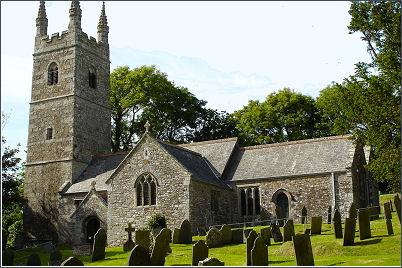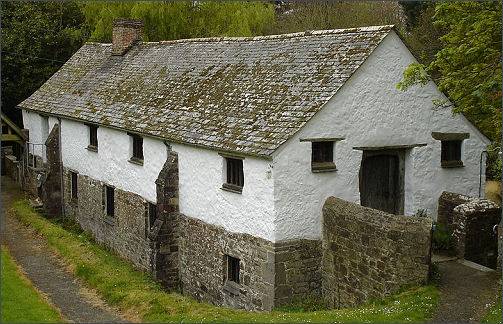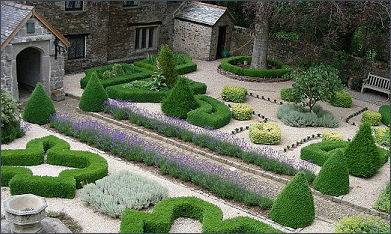Poundstock
OS Grid ref:- SX 202 995
 The characterful Cornish hamlet of Poundstock is situated four miles (6.5 km) to the south of the town of Bude in the far north of the county. Poundstock is an ancient settlement and is mentioned in the Domesday Book of 1086, where it is referred to as 'Pondestock'. The name is of Anglo-Saxon origin and means 'cattle enclosure', the cattle pound was a feature of the village for centuries.
The characterful Cornish hamlet of Poundstock is situated four miles (6.5 km) to the south of the town of Bude in the far north of the county. Poundstock is an ancient settlement and is mentioned in the Domesday Book of 1086, where it is referred to as 'Pondestock'. The name is of Anglo-Saxon origin and means 'cattle enclosure', the cattle pound was a feature of the village for centuries.
The handsome village church which stands in a secluded dell by a small stream, is dedicated to St Winwaloe, A church has occupied this site for fourteen centuries. The present building, which is of medieval origin, consists of a nave, chancel, north transept, north aisle and west tower. The aisle is of fifteenth century date. Poundstock was dedicated to St Winwaloe by 1333, but this was later changed when St Neot was claimed as patron until the 1970s.
 The square granite font probably dates from the Norman era, as do the portions of a nearby pillar-piscina. The pulpit is of Jacobean origin and there are three wall paintings on the north wall, discovered during a restoration of the church. They are much faded but interesting for their iconography, they are the Tree of Deadly Sins, the Warning to Sabbath-breakers and the Weighing of Souls. In the north aisle, the arms of the local Penfound family are displayed with the date 1638.
The square granite font probably dates from the Norman era, as do the portions of a nearby pillar-piscina. The pulpit is of Jacobean origin and there are three wall paintings on the north wall, discovered during a restoration of the church. They are much faded but interesting for their iconography, they are the Tree of Deadly Sins, the Warning to Sabbath-breakers and the Weighing of Souls. In the north aisle, the arms of the local Penfound family are displayed with the date 1638.
The church has an interesting history, the Archbishop of Canterbury visited in 1282, after the Rector of Morwenstow had seized the church and installed his own man as incumbent. No sooner had the Archbishop departed than his candidate was evicted.
In 1357, during a time of bitter rivalry amongst robbers and ruthless pirates of nearby Widemouth Bay, 'Tis said that any man or vessel that dared cross the great Widemouth sound beneath the tallest cliffs of Cornwall, far below the green, green fields of Poundstock were once at the Cornish pirates mercy.' The assistant curate, one William Penfound, ill befitting the role of church curate, was a gang member and apparently quarrelled with his unsavoury colleagues, who vowed revenge. As Penfound assisted at Mass in the Church on December 27th 1357 a band of armed men burst into the Church. William Penfound was brutally murdered in the church and his blood splashed upon vestments and altar furnishings. It is said that his restless ghost may still wanders in the vicinity. Later another vicar of the church was condemned to life imprisonment for complicity in murder, another was hanged in Tudor times for leading a revolt against The Book of Common Prayer, and yet a third gained a reputation as a local lothario.
 Situated next to the church is Poundstock Gildhouse, the unique structure is a well-preserved late medieval church house. The Grade I listed building is the only surviving example of its kind in Cornwall that is still used for its original purpose. It has been used continuously since it was built, Parish feasts were prepared and held here, with profits going to the church. Today it fulfils much the same function.
Situated next to the church is Poundstock Gildhouse, the unique structure is a well-preserved late medieval church house. The Grade I listed building is the only surviving example of its kind in Cornwall that is still used for its original purpose. It has been used continuously since it was built, Parish feasts were prepared and held here, with profits going to the church. Today it fulfils much the same function.
The 1638 plaster royal coat of arms, which now dominates the south end of the feasting hall, it was moved from the church in the 1970s. Following a substantial restoration during 2007-8, under the direction of architect Jonathan Rhind, the Gildhouse received the Royal Institute of British Architects South West Town and Country Conservation award for 2009.
Penfound manor house, (OS Grid reference- SX2299) once home of the Penfound family, is reputed to be haunted. The house is built round a large medieval hall the roof of which has collar-beams on arched braces. Additions to the hall include a massive chimney-stack in the north wall and a small room with solar above at the southwest corner. The windows are Tudor and the entrance porch has a granite doorway with an inscription of 1642. East of this are an inner hall which contains a seventeenth century staircase, said to have been salvaged from a Spanish Armada galleon in 1588 and a former dairy, built in Stuart times. Standing within the four acres grounds, the former courtyard garden was designed and created by gardeners from the Lost Gardens of Heligan.
 Penfound Manor is considered to be the oldest continually-inhabited ancestral family home in England.The manor was originally a Saxon dwelling. It was given by King William the Conqueror, after the Norman conquest of 1066, to his half-brother Robert, Count of Mortain. The Penfound family, who took their name from the manor, occupied the manor during the twelfth century. William Penfound was listed as one of the representitives for Launceston in 1432.
Penfound Manor is considered to be the oldest continually-inhabited ancestral family home in England.The manor was originally a Saxon dwelling. It was given by King William the Conqueror, after the Norman conquest of 1066, to his half-brother Robert, Count of Mortain. The Penfound family, who took their name from the manor, occupied the manor during the twelfth century. William Penfound was listed as one of the representitives for Launceston in 1432.
There is a tale of one Kate Penfound, the daughter of Arthur Penfound, who, during the time of the Civil War, which conflict had a huge effect in Devon and Cornwall, turning neighbours, friends and even families against each other, Kate fell in love with John Trebarfoot of Trebarfoot Manor. The Penfounds supported King Charles I's cause in the conflict, the Trebarfoot family were staunch Parliamentarians who supported Oliver Cromwell against the king. Elopement was the only possible course of action the couple could take. As she was leaving, her Royalist father, Arthur Penfound intervened with his sword. In the ensuing fight John Trebarfoot was killed and Kate and her father died later of wounds received in the melee. Kate received her wounds from her own father when she stepped in to try and stop the fighting. These wounds caused her death and Arthur also died shortly afterwards from his injuries.
The Penfound family suffered for their support of Charles I and after the Civil War found themselves in greatly reduced circumstances. They gave aid to the Jacobite pretender, James Francis Edward Stuart during the 1715 rebellion, which completed their ruin. Ambrose Penfound left his ancestral estate and died at Dartmouth in 1764. The last of the Penfounds died in the poorhouse in 1847.
Pirates, Smugglers and Wreckers of Cornwall